The serene banks of the Ganges in Varanasi set the stage for one of Hinduism’s most captivating rituals – the Evening Arti Ceremony. As the sun dips below the horizon, a mesmerizing performance unfolds, where priests skillfully maneuver brass lamps amidst chants and ringing bells. This captivating spectacle draws devotees and visitors alike, offering a glimpse into the spiritual essence of this ancient city. The ritual’s significance lies in its deep-rooted connection to the cyclical nature of life and death, making it a must-witness event for those seeking to enjoy the rich tapestry of Indian culture. What secrets does this enchanting ceremony hold, and how does it leave a lasting impression on those who witness it?
Good To Know
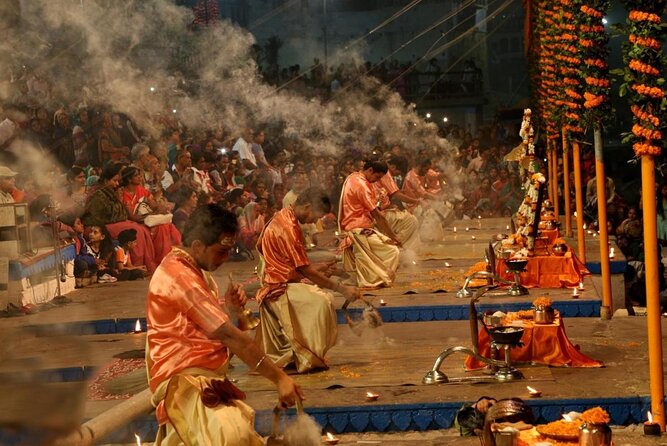
- The Evening Arti Ceremony is an ancient Hindu ritual performed on the banks of the sacred Ganges River in Varanasi, India.
- The ceremony involves a mesmerizing choreography of lit lamps, incense, chants, and ringing bells, creating a captivating spiritual ambiance.
- Attending the ceremony provides a profound cultural experience, offering insights into Hindu philosophy and the cycle of life and death.
- The ceremony takes place at Dasaswamedh Ghat, a historically significant site where Lord Brahma is believed to have welcomed Lord Shiva.
- The event attracts thousands of locals and pilgrims, with early arrival recommended to secure good vantage points amid the increasing crowds.
Overview of the Arti Ceremony
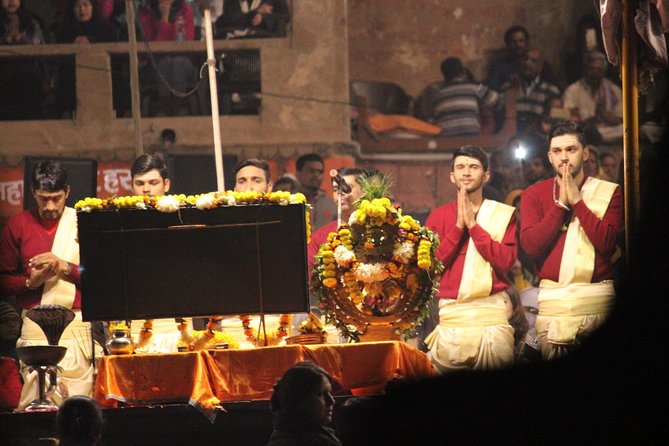
At the banks of the sacred Ganges River in Varanasi, India, the evening Arti ceremony is a captivating ritual that draws thousands of devotees and pilgrims.
During this ceremony, priests perform an ancient Hindu ritual, waving lit lamps and incense to honor the river and the divine. The mesmerizing choreography, accompanied by chants and the ringing of bells, creates an atmosphere of reverence and spirituality.
Attendees participate by offering flowers, prayers, and observing the ceremony, which celebrates the cycle of life and expresses gratitude for the Ganges.
The Arti ceremony is a profound experience, allowing visitors to enjoy the rich cultural heritage of Varanasi.
Ready for more after-sunset magic? More evening tours we love in Varanasi
Hindu Philosophy of Life and Death
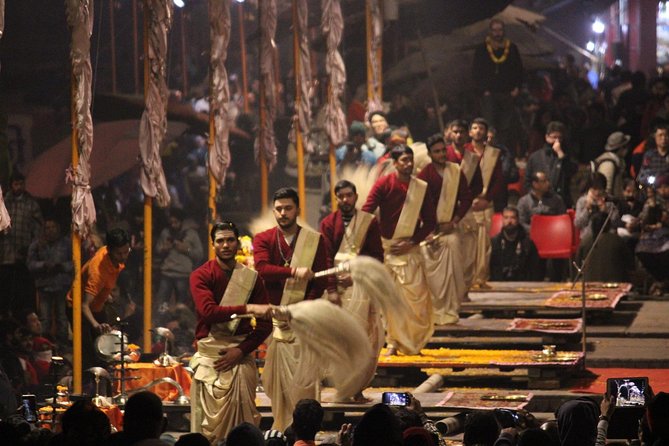
The Manikarnika Ghat, one of the key sites along the Ganges, offers visitors an opportunity to explore the Hindu philosophy of life and death.
This ancient cremation site is considered the gateway to salvation, where the mortal remains of the deceased are ritually burned. As the flames consume the body, Hindus believe the soul is liberated, completing the cycle of reincarnation.
The ghats are abuzz with activity, as funeral processions arrive carrying the deceased wrapped in colorful shrouds.
Visitors can witness the solemn rituals and gaze upon the burning pyres, gaining insight into the Hindu perspective on the impermanence of life and the eternal nature of the soul.
Significance of Dasaswamedh Ghat
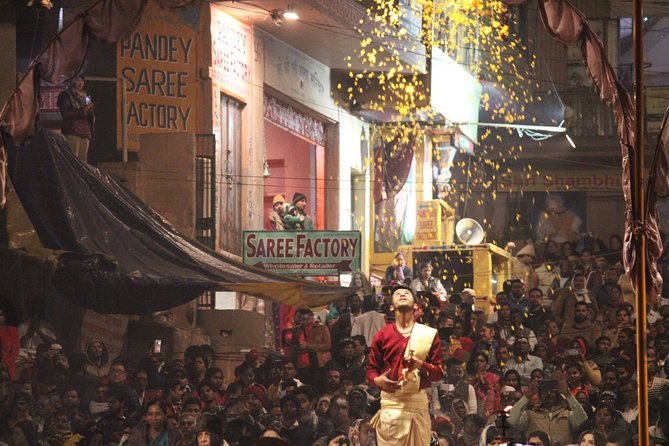
Dasaswamedh Ghat, one of the most significant ritual sites along the Ganges River in Varanasi, hosts a captivating evening Arti ceremony that attracts thousands of locals and pilgrims.
This sacred location is believed to be the site where Lord Brahma performed a yagna, or sacred fire ritual, to welcome Lord Shiva.
The Arti ceremony, which takes place at the ghat every evening, is a theatrical display of light, music, and devotion.
Priests perform intricate choreographed movements with brass lamps, honoring the river goddess Ganga and the setting sun.
The mesmerizing spectacle, accompanied by rhythmic chanting, is a highlight of any visit to Varanasi, showcasing the deep spirituality of this holy city.
Timing and Duration of the Event
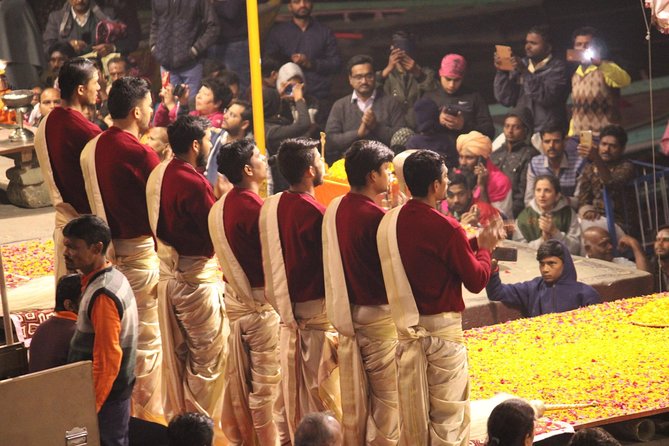
The evening Arti ceremony on the banks of the Ganges typically commences around 6:00 PM and lasts for approximately 1.5 hours.
This significant religious performance takes place at the Dasaswamedh Ghat, one of the most prominent ghats along the river.
During this time, visitors can witness the captivating choreography and atmosphere of the ceremony, which celebrates life and expresses gratitude.
The event often attracts thousands of locals and pilgrims, creating a vibrant and immersive experience.
Attendees should plan to arrive early to secure a good vantage point and be prepared to navigate the crowds during this popular evening ritual.
Inclusions and Pricing Details
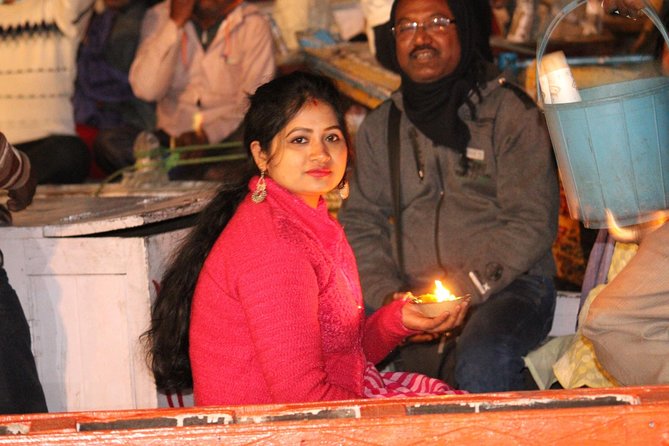
For the evening Arti ceremony on the banks of the Ganges, pricing starts from $40.00 per person, with the exact cost varying based on group size.
This fee includes the Goods and Services Tax (GST) as well as the TripAdvisor Experiences brokerage fee. A professional guide and gratuities are also covered in the package.
Travelers can optionally add hotel pickup and drop-off for an additional cost. Regardless of group size, the experience offers free cancellation up to 24 hours prior to the event.
The maximum group size is 10 people, and the ceremony isn’t suitable for pregnant travelers or those in wheelchairs.
Group Size and Accessibility
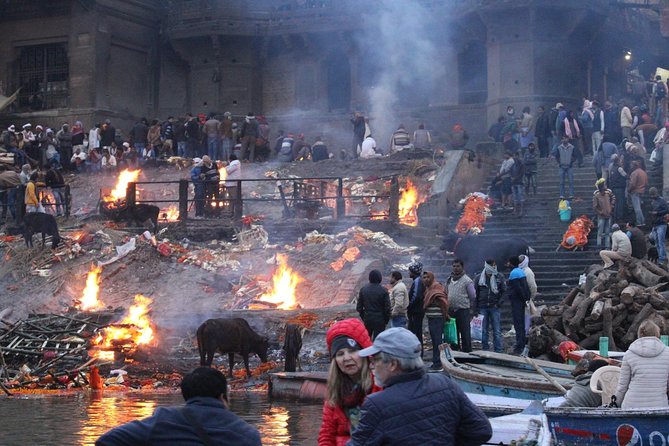
Typically, the evening Arti ceremony on the banks of the Ganges accommodates a maximum group size of 10 people.
The event isn’t wheelchair accessible, and it’s not recommended for pregnant travelers due to the crowds and uneven terrain. Infants must sit on their parents’ laps, as there aren’t designated spaces for strollers or carriers.
While the ceremony is a must-see, it’s essential to consider the accessibility limitations and plan accordingly. Visitors are advised to wear comfortable shoes and bring mosquito repellent to make the most of this immersive cultural experience.
Recommendations for Visitors
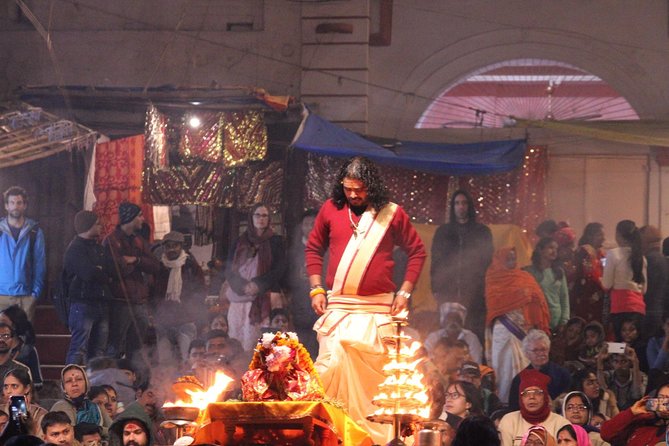
When attending the evening Arti ceremony on the banks of the Ganges, visitors should carry mosquito repellent to ward off any insects. Infants must be held on laps during the event, as it can get quite crowded. Plus, the ceremony is not wheelchair accessible, so visitors with mobility concerns may want to reconsider attending. To ensure a smooth experience, here are some key recommendations:
| Recommendation | Rationale |
|---|---|
| Wear comfortable shoes | Navigating the crowded ghats requires walking |
| Bring water and snacks | The ceremony can last up to 1.5 hours |
| Arrive early | Secure a good viewing spot as it gets increasingly crowded |
| Respect local customs | Observe silently and avoid disrupting the sacred ritual |
| Opt for hotel pickup/drop-off | Avoid the hassle of transportation to and from the event |
Reviews and Ratings
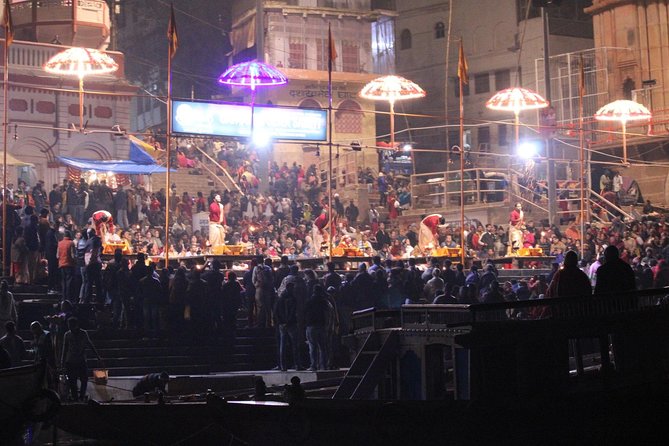
According to the reviews, the Evening Arti Ceremony on the Ganges has received overwhelmingly positive feedback, boasting an impressive 5.0 rating based on 2 reviews.
Travelers have highlighted the guidance provided during the crowded events and the intense, immersive atmosphere of the ceremony. Notable mentions include the intricate choreography and the overall enjoyment, with the event deemed a must-see in Varanasi.
The reviewers noted:
- The ceremony’s ability to capture the essence of Hindu philosophy and the cycle of life and death.
- The captivating religious performance at the Dasaswamedh Ghat.
- The professional guidance of the tour, ensuring a seamless and enriching experience.
- The intense and unforgettable atmosphere, leaving a lasting impression on the participants.
Frequently Asked Questions
What Is the Dress Code for Attending the Ceremony?
The dress code for attending the ceremony is casual and comfortable. Visitors should wear lightweight, breathable clothing that allows them to move freely during the event. There’s no need for formal attire, as the focus is on the spiritual experience.
Are There Any Restrictions on Photography or Videography?
There are some restrictions on photography and videography during the event. Photography is generally allowed, but visitors are advised to avoid using flash or obtrusive equipment to respect the sanctity of the ceremony. Videography may be restricted in certain areas.
Is There a Dress Code for Visitors Participating in the Ceremony?
There’s no strict dress code, but visitors are advised to wear modest, comfortable clothing. Covering up with light, loose fabrics is recommended to respect the sacred nature of the ceremony.
Can Children Attend the Event, and Are There Any Special Accommodations?
Children can attend the event, but infants must sit on laps. While the ceremony isn’t wheelchair accessible, families are welcome. Visitors should carry mosquito repellent and note the maximum group size is 10 people.
Are There Any Nearby Dining Options or Food Vendors During the Ceremony?
There are various food vendors and dining options near the ceremony site. Visitors can sample local street food, such as chaat, poori, and lemonade, from stalls along the ghats. Some hotels and restaurants in the area also offer dinner options before or after the ceremony.
Sum Up
The evening Arti ceremony on the banks of the Ganges in Varanasi is a mesmerizing spectacle that encapsulates the spiritual essence of Hindu culture. Amidst the chants, ringing bells, and skillful maneuvering of brass lamps, the ceremony highlights the reverence for the sacred river and the cycle of life and death. Witnessing this captivating performance leaves a lasting impression on all who attend, providing a profound connection to the rich heritage of Varanasi.
More Evening Experiences in Varanasi
- Full Day Varanasi City Tour With Sarnath and Evening Ganga Aarti
- Private Tour: Full-Day Varanasi Tour Including Sarnath and Evening Ganga Arti
- Private Tour 3-Hour Varanasi Evening Aarti
- 2 Night 3 Days Experience Varanasi Tour
- Private Evening Ceremony Aarti With Bazar & Street Food
- Bodhgaya Tour From Varanasi 2 Days 1 Night
More Tour Reviews in Varanasi
Not for you? Here's more things to do in Varanasi we have recnetly reviewed
- 20 Best 2 Day Tours In Varanasi
- 20 Best 3 Day Tours In Varanasi
- 25 Best Cruises And Boat Tours In Varanasi
- 6 Best Food Tours In Varanasi
- 15 Best Full-Day Tours In Varanasi
- 2 Best 4 Day Tours In Varanasi
- 7 Best Photography Experiences In Varanasi
- 8 Best Dining Experiences In Varanasi
- 8 Best Dinner Tours In Varanasi
- Varanasi: Ganga Arti Evening Light Ceremony on the Main Ghat
- Learn to Play a Traditional Indian Instrument in Varanasi!
- Day Trip of Haridwar and Rishikesh From Delhi By Car
